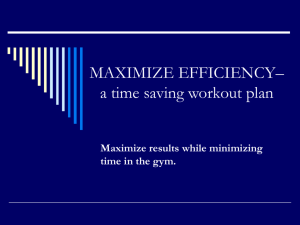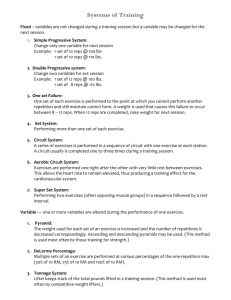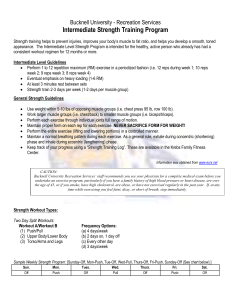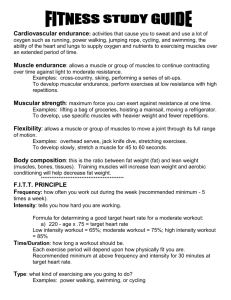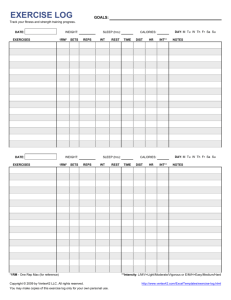Creating A Workout Plan
advertisement
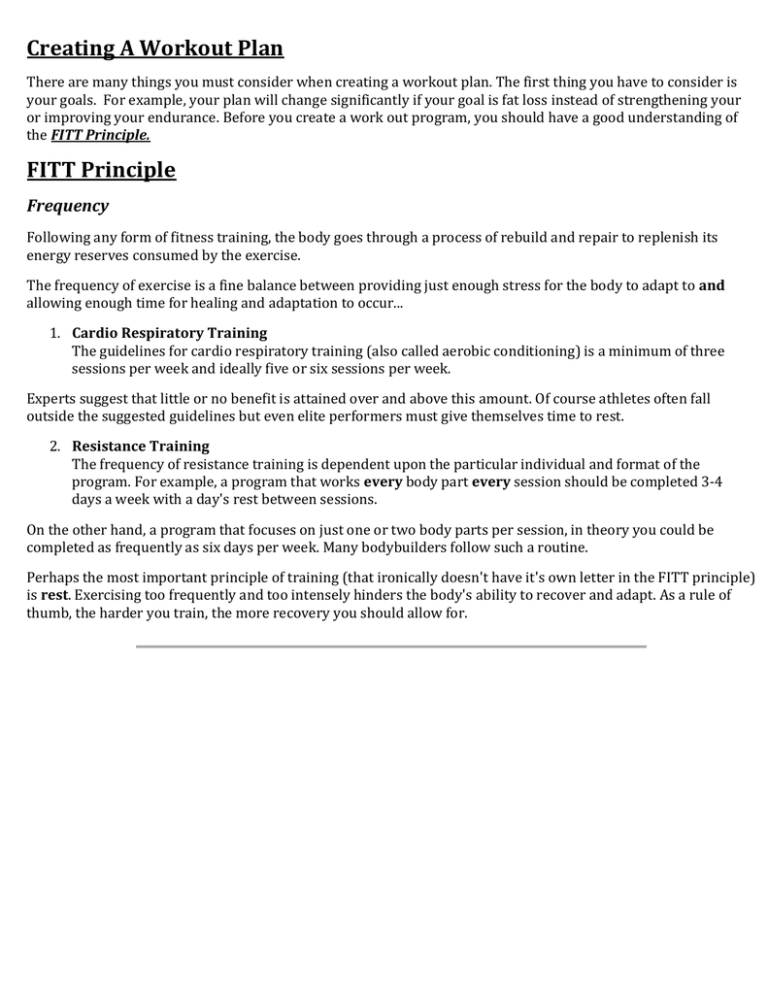
Creating A Workout Plan There are many things you must consider when creating a workout plan. The first thing you have to consider is your goals. For example, your plan will change significantly if your goal is fat loss instead of strengthening your or improving your endurance. Before you create a work out program, you should have a good understanding of the FITT Principle. FITT Principle Frequency Following any form of fitness training, the body goes through a process of rebuild and repair to replenish its energy reserves consumed by the exercise. The frequency of exercise is a fine balance between providing just enough stress for the body to adapt to and allowing enough time for healing and adaptation to occur... 1. Cardio Respiratory Training The guidelines for cardio respiratory training (also called aerobic conditioning) is a minimum of three sessions per week and ideally five or six sessions per week. Experts suggest that little or no benefit is attained over and above this amount. Of course athletes often fall outside the suggested guidelines but even elite performers must give themselves time to rest. 2. Resistance Training The frequency of resistance training is dependent upon the particular individual and format of the program. For example, a program that works every body part every session should be completed 3-4 days a week with a day's rest between sessions. On the other hand, a program that focuses on just one or two body parts per session, in theory you could be completed as frequently as six days per week. Many bodybuilders follow such a routine. Perhaps the most important principle of training (that ironically doesn't have it's own letter in the FITT principle) is rest. Exercising too frequently and too intensely hinders the body's ability to recover and adapt. As a rule of thumb, the harder you train, the more recovery you should allow for. INTENSITY The second rule in the FITT principle relates to intensity. It defines the amount of effort that should be invested in a training program or any one session. There must be a balance between finding enough intensity to overload the body (so it can adapt) but not so much that it causes overtraining. Heart rate can be used to measure the intensity of cardio respiratory training. Workload is used to define the intensity of resistance training. 1. Cardio Respiratory Training Heart rate is the primary measure of intensity in aerobic endurance training. Ideally before you start an aerobic training program a target heart rate zone should first be determined. The target heart rate zone is a function of both your fitness level and age. Here's a quick method for determining your target heart rate... Heart Rate & Maximum Heart Rate Heart rate is measured as beats per minute (bpm). Heart rate can be monitored and measured by taking your pulse at the wrist, arm or neck. An approximation of maximum heart rate (MHR) can also be calculated as follows: MHR = 220 - age. Target Heart Rate For beginners a target heart rate zone of 50-70 percent of their maximum of heart rate is a good place to start. So if, for example, you are 40 years old that gives you a predicted maximum heart rate of 180 (220 - 40). Multiply 180 by 50% and 70% and your reach a target zone of 90bpm - 126bpm. For fitter, more advanced individuals, a target heart rate zone of 70-85 percent of their maximum of heart rate may be more appropriate. Staying with the example above, that 40 year old now has a heart rate zone of 126bpm - 153bpm. There are limitations with heart rate and the heart rate reserve method, while no means flawless, may be a more accurate way to determine exercise intensity. 2. Resistance Training For resistance training, workload is the primary measure of intensity. Workload can have three components: 1. The amount of weight lifted during an exercise 2. The number of repetitions completed for a particular exercise 3. The length of time to complete all exercises in a set or total training session So, you can increase workload by lifting heavier weights. Or you could increase the number of repetitions with the same weight. Finally, you could lift the same weight for the same number of repetitions but decrease the rest time between sets. However, only increase the intensity using one of the above parameters. Do not increase weight and decrease rest time in the same session for example. TYPE The third component in the FITT principle dictates what type or kind of exercise you should choose to achieve the appropriate training response... Cardio Respiratory Training Using the FITT principle, the best type of exercise to tax or improve the cardiovascular system should be continuous in nature and make use of large muscle groups. Examples include running, walking, swimming, dancing, cycling, aerobics classes, circuit training, cycling etc. Resistance Training This is fairly obvious too. The best form of exercise to stress the neuromuscular system is resistance training. But resistance training does not necessarily mean lifting weights. Resistance bands could be used as an alternative or perhaps a circuit training session that only incorporates bodyweight exercises. Changing the type of exercise for each muscle is also important. For example, push-ups will work your pectoral muscles, but doing push-ups three times a week will not show the same benefit as doing three different pectoral exercise. TIME The final component in the FITT principle of training is time - or how long you should be exercising for. Is longer better? Cardio Respiratory Training Individuals with lower fitness levels should aim to maintain their heart rate within the target heart rate zone for a minimum of 20-30 minutes. This can increase to as much as 45-60 minutes as fitness levels increase. Beyond the 45-60 minute mark there are diminished returns. For all that extra effort, the associated benefits are minimal. This also applies to many athletes. Beyond a certain point they run the risk of overtraining and injury. There are exceptions however - typically the ultra-long distance endurance athletes. In terms of the duration of the program as a whole, research suggests a minimum of 6 weeks is required to see noticeable improvement and as much as a year or more before a peak in fitness is reached. Resistance Training The common consensus for the duration of resistance training session is no longer than 45-60 minutes. Again, intensity has a say and particularly grueling strength sessions may last as little as 20 - 30 minutes. Resistance Training All resistance plans should begin with a cardio warm-up and finish with a cool-down period of stretching. Before you begin, you need to know the definition of two simple words used in weight training, Rep and Set. Rep is short for repetition. Each rep is one lift, up and down. A set is the number of reps you do in a row without a pause. For high strength and power you should probably do 6 to 8 reps. A longer rest of 2 to 5 minutes between sets is needed for heavy weights and low reps. For high endurance you can do between 10 and 20 reps. To keep your heart rate elevated you shouldn't rest more than one minute between sets. If your goal is both endurance and strength a good range is 8 to 12 reps, with a rest of one to two minutes between sets. Between two and four sets of each exercise is enough. But if you don't have much time, one set is better than none, as long as you're fatiguing the muscles. For beginners, working out one hour, three days a week is a good goal. It gives you time in each workout to do your warm-up, 12 to 15 sets and a cool down with stretching. As you get more advanced you can increase the number of workouts per week up to six. Concentrate on working your body hard enough so that the last rep of each set is all you can do. The amount of weight you use depends on how strong you are. Don't go crazy and try to lift something so heavy you injure yourself. If you're using free weights or dumbbells make sure to have a spotter around. (A spotter is someone who stands by ready to help you if you can't complete a rep.) If you find you can't complete the set in good form, choose a lighter weight for the next set. Likewise you should increase the weight if the previous weight has gotten too light. And always record the weight, sets and reps to chart your progress. There are three important things to consider when you're building a program: Balance. Every muscle is balanced by another. Upper body and lower body; biceps and triceps or chest and back. Maintaining balance is important, never neglect one muscle group for another. If you over-train one part of your body while neglecting another it not only looks bad but can cause injury. Recovery. Muscles grow while resting between workouts, not when you're lifting weights, so recovery time is critical. Don't work the same body part two days in a row. Give it 48 hours to recover. That doesn't mean you're limited to working upper body one day and lower body the next. You could work chest and biceps one day, while working back and triceps the next. Resistance Does Not Necessarily Mean Weights – keep in mind that exercises like dips, pushups, crunches, jumping jacks, mountain climbers and core muscles exercises are all great exercises to incorporate into a resistance training program. An exercise does not have to infvolve lifting a dumbbell or working on a machine to qualify as resistance. What Exercises Should I Choose? When deciding what exercises to choose, it is important to consider the muscle groups that you would like to work on a given day. It is a good idea to create 3 different workout to target the major muscle groups and to give them the proper amount of rest. When creating your workouts, you should consider that some muscles will be worked when you do not intend them to be. All muscles work in antagonist/protagonist pairs. This means that when a muscle is contracted, the opposite muscle is relaxed. For this reason, you want to avoid working these two muscles on the same day. For example, when you are doing bicep curls, the tricep also receives a workout. This means that you would avoid working both the bicep and tricep on the same day. A good way to break up your exercises is to follow the muscle groupings below: Workout 1 – Back & Biceps Workout 2 – Chest & Triceps Workout 3 – Shoulders, Core & Legs How Many Exercises Should I choose? The answer to this question depends on the time you have available for your workout. We have 60 minutes per class (after 5 minutes of change time on either end) but 10 minutes of warm-up and 5 minutes of cool down stretching leaves you with 45 minutes of training time. On days where you are working 2 muscle groups, you could choose 3-4 exercises per muscle group, but on a day where you are working 3 muscle groups, you will only have time for 2-3 exercises per muscle group. The bottom line is that you will not have time for more than 10 exercises in one class period, so don’t plan for more than that. Cardiovascular Workout Although it is commonly believed that the only way to lose weight is to do a cardio workout (running, elliptical and stationery bike, etc.) in actuality, weight training is a great way to burn calories and lose weight. The key to burning calories in this manner is to combine cardiovascular exercises with resistance exercise (low weight and high reps). The key to this method is very little rest time between exercises and alternating cardio with resistance. For example, you may run for 5 minutes, 20 bicep curls, 30 curls, 5 minutes stationary bike, 50 jumping jacks, etc. Cardiovascular exercises alone will burn fat, but will not shape your body the way that you want it to look. Assignment: Creating A Workout Plan Using the template below, create three workout plans that will help you to achieve your goals. Each workout should work 2-3 major muscle groups as outlined in the lesson. You should also tailor your sets and reps to your goal of endurance or strength. You can find exercises for each muscle group online. You can print off copies of the description of each exercise and attach them to your work out plan. This will help you remember what the exercise is when it comes time to do it. You will be using these workout plans beginning next week, but they must be reviewed with your teacher before you can use them. Name: ___________________________________ Goal: (Circle One) Strength Date: ______________________________ Warm Up: ______________________________ CARDIO EXERCISES Weight Loss Body Parts WORKOUT 1 EXERCISES Endurance SET1 REPS TIME DIST WT SET2 REPS TIME DIST WT SET3 REPS TIME DIST WT SET4 REPS TIME DIST WT Name: ___________________________________ Goal: (Circle One) Strength Date: ______________________________ Warm Up: ______________________________ CARDIO EXERCISES Weight Loss Body Parts WORKOUT 2 EXERCISES Endurance SET1 REPS TIME DIST WT SET2 REPS TIME DIST WT SET3 REPS TIME DIST WT SET4 REPS TIME DIST WT Name: ___________________________________ Goal: (Circle One) Strength Date: ______________________________ Warm Up: ______________________________ CARDIO EXERCISES Weight Loss Body Parts WORKOUT 3 EXERCISES Endurance SET1 REPS TIME DIST WT SET2 REPS TIME DIST WT SET3 REPS TIME DIST WT SET4 REPS TIME DIST WT

